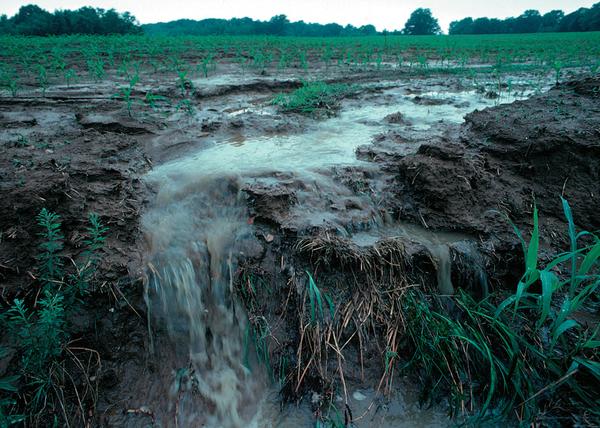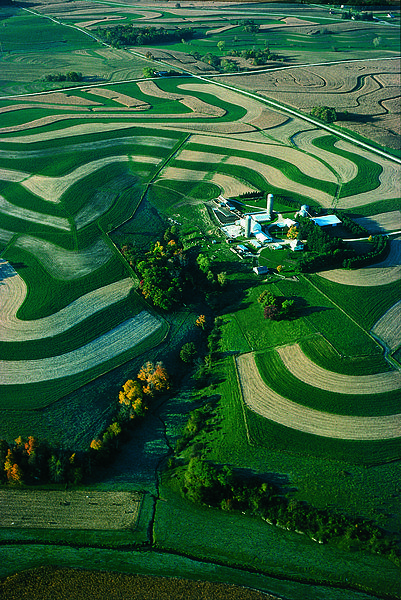Soil provides important ecosystem services that support different processes in nature, including nutrient cycling and gas exchange. In these cycles, water fluxes are important in cycling nutrients through the soil-plant-atmosphere pathway and are important in transferring nutrients and other particles from the soil to nearby water bodies. Soil has the capacity to absorb rainwater, store it temporarily, and release it to plants and soil organisms. Soil also filters water-dissolved materials and releases water into surface water and groundwater.
Erosion, Sedimentation, and Runoff
When a soil is well managed, it can be an efficient rainwater sponge. If the soil is improperly managed, however, infiltration into the soil can be greatly reduced and the water may run off the surface, carrying soil particles with it. This process, called soil erosion, has been a major cause of soil degradation in North Carolina for many years (Figure 1). Further, damage to water quality occurs when this eroded soil enters surface waters.
Sedimentation occurs when water carrying eroded soil particles slows long enough to allow soil particles to settle out. The smaller the particle, the longer it stays in suspension. Larger, heavier particles such as gravel and sand settle out sooner than smaller, lighter particles such as clay. Clay may stay in suspension for very long periods, contributing significantly to water turbidity (cloudiness).
Sediment comes from many sources, including agricultural fields, forestry operations, eroding streambanks, construction sites, and mining operations. Sediment is the largest water pollutant by volume in North Carolina. It affects water quality physically, chemically, and biologically. Damage from sediment is expensive, both economically and environmentally. Sedimentation destroys fish spawning beds, reduces useful storage volume in reservoirs, clogs streams, and makes costly filtration necessary for municipal water supplies. Suspended sediment can kill aquatic plant life and alter a stream's ecology. Because the environmental damage from sediment is often cumulative, the ultimate effects and costs may not be evident for years. The consequences of off-site sedimentation can be severe, both for people immediately affected and those who must cope with subsequent problems.
Sediment often carries organic matter, animal or industrial wastes, nutrients, and chemicals. The most troublesome nutrient element is phosphorus. In freshwater ecosystems with typically very low phosphorus conditions, large additions of phosphorus can stimulate the production of algae blooms. As the algae die, microorganisms in the aquatic system decompose the algae, using it as a food source. In the process, microbes also use significant amounts of oxygen. If the oxygen level is initially low, the decomposition process can further reduce it enough that fish kills can occur. Phosphorus may come from such sources as fertilizers, organic matter, and animal manure. Phosphorus is immobile in most soils and concentrates in the top few inches of the soil profile, which is susceptible to erosion. Therefore, phosphorus is likely to be present in runoff sediment.
Sediment also may carry pesticides, such as herbicides and insecticides, that may be toxic to aquatic plants and animals. The varying chemical properties of pesticides—for example, their solubility, toxicity, and chemical breakdown rate—determine the potential damage to water quality.

Figure 1. Runoff water can transport chemicals and remove uniform amounts of soil from a wide area.
U.S. Department of Agriculture, Natural Resources Conservation Service CC BY 2.0
Leaching
Certain dissolved nutrients and pesticides are highly mobile and can reach the groundwater by moving down through the soil (leaching). Nitrogen, in the form of nitrate (NO3-), is highly mobile and may cause human and animal health problems when concentrations exceed 10 milligrams of nitrogen per liter (44 mg of NO3-). In waters where nitrogen deficiency limits growth within the ecosystem, added nitrogen stimulates algae growth in the same manner as phosphorus. Despite the problems related to nitrogen leaching, some other nutrients present in fertilizers are not likely to cause environmental problems. For example, chlorine, in the form of ion chloride (Cl-), is present in some fertilizers and is easily leached from soil, though without any adverse effect on the environment. Likewise, ion sulfate (SO42-) and potassium (K+) also are present in some fertilizers; part of these nutrients can be leached depending on soil texture and rainfall, but they do not cause adverse impacts on the environment.
Household Wastewater Disposal
Soils can be used to filter and absorb the waste constituents of wastewater from septic systems. About half of North Carolina residents depend on septic systems (and hence on soil absorption) for the treatment and disposal of their household wastewater. More than 1 million housing units in the state use on-site septic systems to dispose of their wastewater. At least 30,000 additional septic tank systems are installed each year. Each day, septic systems in North Carolina discharge more than 100 million gallons of sewage into the soil.
Septic systems should be used only in soils that can filter, absorb, and treat waste constituents. Key soil properties to consider include depth, texture, structure, drainage, color, and the presence of layers that restrict water flow. To discover any limitations, these properties should be evaluated by a professional to a depth of at least 6 feet.
Each region of North Carolina has its own potential hindrances for septic tank installation. In the piedmont, installation is difficult in thin, shallow soils over bedrock and in clayey soils whose mineral content causes them to swell extensively when wet. In the coastal plain, problems with water contamination may result from a seasonally high water table that is close to the soil surface. In the mountains, installation is difficult on steep slopes, in shallow soils, and at the base of long slopes where subsurface water can accumulate. Alternatives to conventional septic systems need to be considered in these problem areas.
Land Application of Nutrient Containing Organic Materials
Municipalities and industries often apply sludge from wastewater treatment plants to agricultural land (see NC State Extension publication AG-439-3, Land Application of Municipal Sludge: Advantages and Concerns). Applications of livestock and poultry manure are popular because of an increase in their availability and new regulations governing manure management. Land application is an appropriate use of these products, provided their nutrient characteristics are known and matched with a suitable cropping system that will utilize these nutrients.
The characteristics of the wastes determine the allowable land application rates. Each waste type will contain one constituent that limits the amount that can be safely applied to land. This limiting constituent may be one of the plant nutrients such as nitrogen or phosphorus, one of the heavy metals such as zinc, copper, cadmium, or lead, or other constituents such as sodium or calcium carbonate. Waste regulations administered by the state and recommendations developed by North Carolina State University provide information on correct loading rates. Updated information is available at the Nutrient Management in North Carolina website. With most wastes generated in North Carolina and applied to supply the nitrogen and phosphorus needs of a crop, following recommendations based on an analysis of the waste and soil will prevent health hazards and crop toxicities. The soil's capacity to use, retain, or reduce the undesirable effects of waste varies significantly according to the physical, chemical, and biological properties of the soil and the characteristics of the wastes. Thus, the development of a land treatment system must be tailored to the characteristics of the specific site and the specific waste. The following are among the characteristics that may disqualify a site: steep slopes; very clayey or sandy soils; nearby streams, wells, and property lines; a likelihood of flooding; and shallow depth to bedrock or the water table. Because each site has a finite capacity to accept certain waste constituents (for example, heavy metals such as zinc, copper, and cadmium), a threshold may be reached beyond which land application of wastes is no longer acceptable.
lmportance of Good Soil Management
An understanding of soil properties and how they determine best management practices is essential for reducing the movement of nutrients and pollutants from the land to our waters.
Reducing soil erosion is the key to reducing the damaging effects of sedimentation. Fortunately, modern technologies and management practices can reduce erosion to acceptable levels. The challenge is to match the appropriate technology to each situation.
The Natural Resources Conservation Service has developed a variety of practices for improving surface water quality. Crops, crop residues, and structures are used alone or in combination to hold the soil in place and allow water to move into it rather than run off the surface. Agricultural practices such as strip-cropping, contour cultivation, and filter strips are beneficial and economical (Figure 2). Sometimes more costly structures such as grassed waterways and terraces are required to provide the necessary control. Conservation tillage, which reduces soil disturbance and preserves the soil cover with plant residues, is another effective way to reduce erosion.
Various conservation practices enhance surface water quality by controlling erosion. Some of these practices, such as riparian buffers, have little effect on groundwater, whereas other practices have antagonistic effects, such as conservation tillage, which decreases phosphorus losses by preventing erosion but can increase nitrogen leaching. The careful use of fertilizers, animal wastes, and pesticides is important in protecting groundwater and surface water quality.
Soil properties and crop needs determine the proper amounts of fertilizers and pesticides to apply and the timing and method of their application. For example, sandy soils can leach more nutrients and other applied materials than heavier soils with more clay. Thus, the amount, frequency, and timing of nutrient applications need to be adjusted for each situation. Furthermore, inputs should be based on realistic crop yield expectations that vary with soil properties. Adopting best management practices helps avoid excessive levels of elements such as nitrogen and phosphorus that can become harmful when lost to the environment.
Contamination from home waste disposal systems can be prevented. A professional sanitarian should carefully examine home sites to ensure that the soil characteristics are suitable for the installation of septic systems. For more information, see NC State Extension publication AG-439-13, Septic Systems and their Maintenance.
The land application of wastes is now an essential part of nutrient management programs. The composition and properties of the waste need to be known before it is applied. When applying municipal sludge, compost, or any other form of organic wastes to a field, match the soil and crop system nitrogen needs to the nitrogen content of the organic source. Mixing organic materials into the soil reduces losses due to ammonia-nitrogen gas emissions.
Manure application rates should be based on the available portion of the nutrients and should not exceed the nutrient requirements of the crop. Excessive loading may result in surface water and groundwater pollution. For more information on livestock and poultry manure, see NC State Extension publications AG-439-4, Swine Manure as a Fertilizer Source, AG-439-5, Poultry Manure as a Fertilizer Source, AG-439-28, and Dairy Manure as a Fertilizer Source, and also the North Carolina Agricultural Chemicals Manual. Soil testing also should be conducted to determine proper loading rates. Examples of how to compute manure application rates are outlined in these publications.

Figure 2. Strip-cropping provides an efficient means of controlling runoff problems.
U.S. Department of Agriculture, Natural Resources Conservation Service CC BY 2.0
Conclusion
Many agricultural and industrial practices can threaten water quality if soil properties and capabilities are poorly understood or are ignored. These threats are serious, but they also are manageable. Water quality can be improved while protecting the productivity and value of the soil for agricultural, industrial, and recreational uses. We can have both healthy soil and clean water by applying good soil management practices.
Acknowledgements
This publication is a revision of an earlier version. The authors would like to thank D. Crouse, J. Godfrey, R. McLaughlin, M. Cook, S. C. Hodges, G. Nadermand and J. P. Zublena for their earlier contributions.
Publication date: May 1, 2020
AG-439-01
N.C. Cooperative Extension prohibits discrimination and harassment regardless of age, color, disability, family and marital status, gender identity, national origin, political beliefs, race, religion, sex (including pregnancy), sexual orientation and veteran status.
